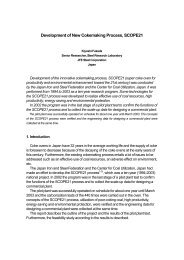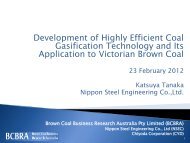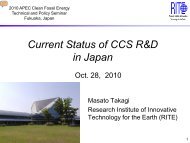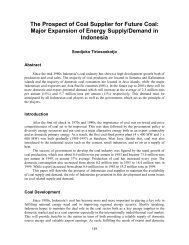Defining CCS Ready: An Approach to An International Definition
Defining CCS Ready: An Approach to An International Definition
Defining CCS Ready: An Approach to An International Definition
- No tags were found...
Create successful ePaper yourself
Turn your PDF publications into a flip-book with our unique Google optimized e-Paper software.
Appendix B: Technology Design Options for a Capture <strong>Ready</strong> Plan<strong>to</strong>f retrofit—at least when low-temperature solvents are used for desulphurization. If a wetquench is used, the resulting syngas contains considerable moisture content, which isbeneficial for the water/gas shift section. However, if a sweet shift is used with lowtemperaturedesulphurization, this syngas flow needs <strong>to</strong> be cooled down considerably andmost of the water will condense. The consequence is that much steam needs <strong>to</strong> be addedafter desulphurization for the shift reaction, considerably decreasing power output andefficiency. In other words, a wet quench limits the possibilities <strong>to</strong> apply a sweet shift afterretrofit. A syngas cooler does not affect the sweet vs. sour shift decision as much.Water Gas Shift Section<strong>An</strong> obvious change during the retrofit is the incorporation of shift reac<strong>to</strong>rs and heatexchangers as part of the shift section. Depending on the shift arrangement (classical shiftwith two reac<strong>to</strong>rs and intercooling vs. advanced shift with up <strong>to</strong> four reac<strong>to</strong>rs or possiblyalternative arrangements), different tie-ins and integration options with the hot water/steamcycle are required. As the shift section also hydrolyses COS in<strong>to</strong> H 2 S, the COS hydrolysisreac<strong>to</strong>r is no longer required if a sour shift arrangement is chosen. These considerationsmainly apply <strong>to</strong> IGCCs.It is worth mentioning here that Jacobs Engineering has proposed <strong>to</strong> include a water gasshift reac<strong>to</strong>r from the start; i.e., even when not capturing CO 2 , as a Capture <strong>Ready</strong>option. 141 <strong>An</strong> important benefit of this option is that the extent of retrofit changes issubstantially reduced, with the gasification train already at the right size for capture, whichwill reduce downtime during the retrofit. However, it comes at the expense of a reducedefficiency before retrofit (around 5% additional fuel consumption) and increased initialcapital cost. 142Sulphur and CO 2 SeparationCapture <strong>Ready</strong> considerations can also be important for the desulphurization section ofIGCCs. Optimal solvents for sulphur removal in IGCCs without CO 2 capture (oftenchemical solvents such as Sulfinol) are usually not the optimal choice for IGCCs with CO 2capture (often physical solvents such as Rectisol or Selexol are preferred). A Capture <strong>Ready</strong>desulphurization design could already use the solvent anticipated <strong>to</strong> be used after retrofit,and ideally the desulphurization equipment could also be reused after retrofit. This wouldmean that the only change at the time of retrofit may be addition of a column and auxiliaries<strong>to</strong> also remove the CO 2 from the syngas stream. Linde has shown that such a Capture<strong>Ready</strong> desulphurization plant using Rectisol can significantly reduce the cost for CO 2removal at the time of retrofit, although at the cost of elevated investment cost when thepower plant is built. 143141 <strong>International</strong> Energy Agency Greenhouse Gas R&D Programme (IEA GHG). (2005). Retrofit of CO2 capture <strong>to</strong> naturalgas combined cycle power plants (Report no. 2005/1). Cheltenham, UK: Author.142 <strong>International</strong> Energy Agency Greenhouse Gas R&D Programme (IEA GHG). (2007a). CO2 capture ready plants (Reportno. 2007/4). Cheltenham, UK: Author.143 Kerestecioglu et al.. (2009). Stepwise Extension of a Gas Cleanup for IGCC Application. Presented at the 4th<strong>International</strong> Conference on Clean Coal Technologies, May 18-20, 2009, Dresden, Germany.23 February 2010 90
















